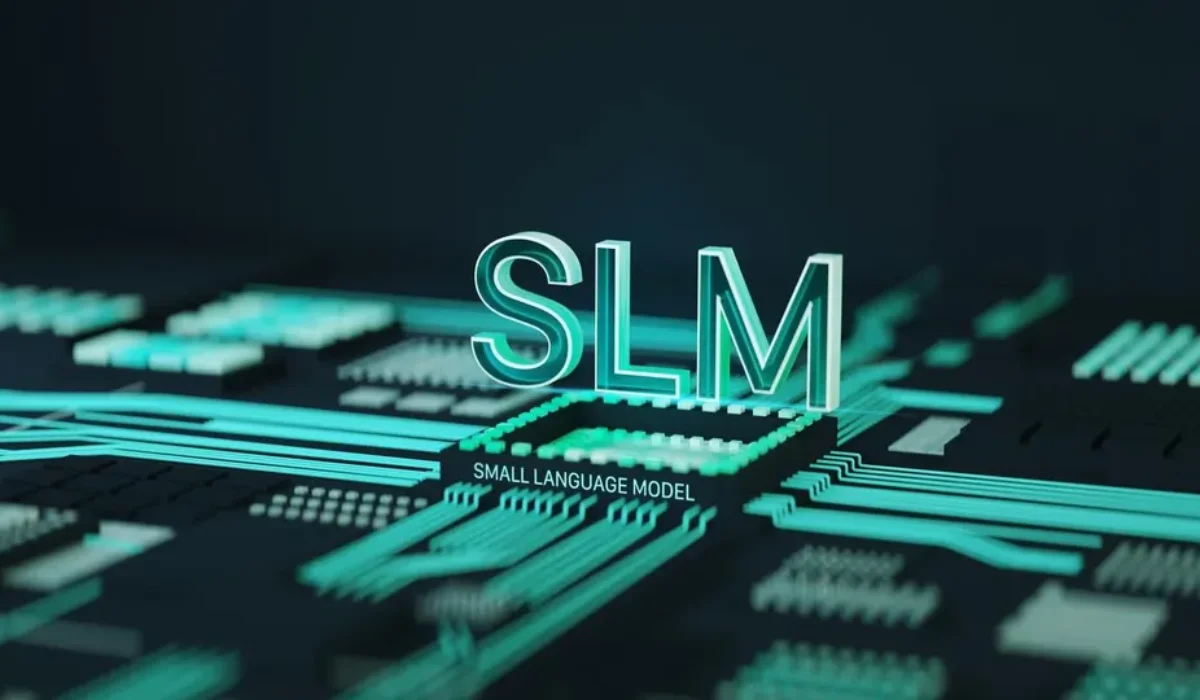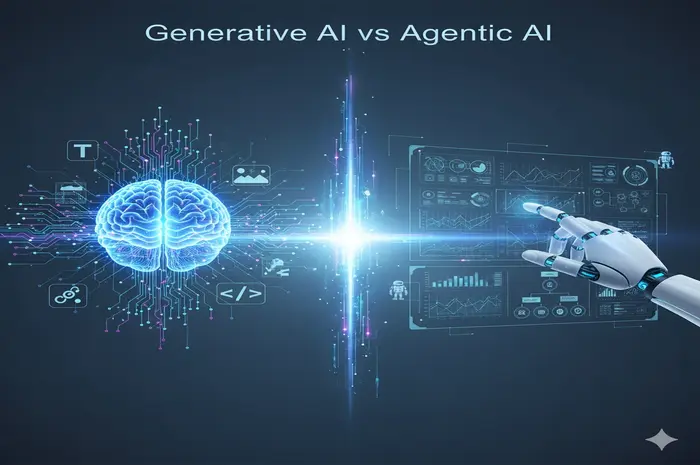The competitive gap in 2025 isn’t between businesses that use AI and those that don’t, it’s between those that treat AI as a strategic capability and those that treat it as a tool.
Enterprises that advanced early are now facing a new challenge: scaling AI responsibly, efficiently, and profitably. Budgets have grown sharply, yet ROI remains inconsistent. Regulatory scrutiny is rising. Models that once impressed in pilot projects are not doing well under real circumstances, shifting the real question from “how to adopt AI” to “how to operationalize it as business infrastructure.”
Here are top 11 AI technology trends for enterprises that define the new shift, investment, and how leaders can align governance, workforce, and architecture to sustain impact.
11 Trends in AI That Will Dominate the Future of Enterprise
1. Agentic AI: From Assistance to Autonomy

Every enterprise leader this year is asking the same question: how much decision-making can we safely hand over to machines? That’s the promise and pressure behind Agentic AI.
Unlike traditional automation that executes fixed tasks, Agentic AI systems can interpret situations, plan responses, and act within defined goals. They don’t just follow instructions; they reason. It’s the difference between an assistant that waits for commands and one that anticipates the next move.
The momentum is real. Funding in agentic AI has jumped more than 250 percent since late 2024, and Gartner expects a third of enterprise software to include autonomous capabilities within three years. Early adopters are using it to streamline IT operations, accelerate service resolution, and run predictive maintenance, areas where judgment and action can be codified into repeatable loops.
Yet, many projects are stalling. Costs climb fast when autonomy meets messy data and unclear accountability. Some firms over-automate before defining where human oversight should remain. Others discover too late that “autonomous” doesn’t mean “self-managing.”
The practical path is narrower but more rewarding: start with domains that are high-value and bounded by clear rules – compliance checks, invoice validation, or logistics optimization. Pair domain experts with AI teams to set limits, monitor reasoning, and refine behavior.
Takeaway: Treat Agentic AI as a new management discipline, not a plug-in feature. Its success depends on how well your organization designs trust, not just code.
2. Multimodal AI: Turning Fragmented Data into Unified Intelligence

Most enterprises are drowning in data variety, documents, images, videos, audio logs, all valuable, none designed to work together. Multimodal AI is changing that equation.
These systems can interpret and connect different data types in a single model, letting organizations see patterns that text-only or image-only systems miss. An AI compliance tool can now read contracts, scan supporting documents, and flag mismatched signatures; a customer service model can read transcripts, detect tone, and review product photos, all in one flow.
The results are tangible. McKinsey’s State of AI 2025 found that businesses adopting multimodal architectures process information 60% faster and achieve up to 40% higher customer satisfaction. And as generative AI moves in this direction, Gartner expects nearly half of enterprise solutions to become multimodal by 2027.
But capability comes with complexity. Integrating structured and unstructured data exposes weak governance and inconsistent metadata. Without clear data lineage, multimodal models amplify noise instead of insight.
For leaders, the priority isn’t to chase every use case, it’s to decide where connected context creates measurable advantage. Start where multiple data sources already converge: compliance monitoring, claims processing, or product quality analysis.
Takeaway: Multimodal AI isn’t about sophistication for its own sake; it’s about closing the information gap between systems that know and systems that decide.
Also Read: What is Synthetic Intelligence?
3. Enterprise AI Governance is Mandatory

For years, “responsible AI” sat in the ethics column of corporate reports. In 2025, it sits in the risk register. The EU AI Act, the NIST AI Risk Management Framework, and ISO 42001 have made governance a board-level priority. Non-compliance now carries financial and reputational consequences too large to ignore.
Enterprises that built early governance frameworks are already seeing the payoff. Studies show they experience 23% fewer AI-related incidents and 31% faster go-to-market for new AI features. Mature programs treat governance not as a control function but as a performance system, one that improves model accuracy, customer trust, and regulatory confidence simultaneously.
What’s becoming standard:
- Clear accountability for model decisions.
- Documented data provenance and bias testing.
- Human oversight for high-impact use cases.
- Continuous monitoring with auditable trails.
The shift is cultural as much as technical. Governance requires cross-functional ownership- legal, data, security, and product teams aligned around a shared framework. Without it, even well-designed models drift into opacity.
Takeaway: Building competitive AI infrastructure requires more than tools, it demands disciplined architecture, governance, and integration. Partnering with an experienced enterprise AI development services provider ensures AI scales with control, compliance, and measurable business impact.
4. Retrieval-Augmented Generation (RAG): The Backbone of Trustworthy AI

Generative AI gives enterprises speed; RAG gives AI the mind and reliability. It solves the credibility problem that has limited AI adoption in high-stakes business environments.
Traditional large language models draw on static training data. That makes them powerful, but also risky, especially when outdated or incomplete information can shape real decisions. RAG (Retrieval-Augmented Generation) changes that by connecting models to verified, real-time data sources. It retrieves the most relevant facts before generating a response, grounding outputs in truth rather than probability.
Enterprises are using RAG to power knowledge assistants, compliance bots, and analytics copilots that can reference internal databases or document repositories securely. Microsoft, AWS, and Google have made RAG central to their enterprise AI stacks, signaling that this isn’t a niche technique, it’s the new standard for production-grade AI.
For most organizations, the advantage is twofold:
- Accuracy and compliance. RAG reduces hallucinations and supports auditability.
- Cost control. Instead of retraining models repeatedly, you refresh the retrieval layer, dramatically lowering operational spend.
But the architecture only works when data hygiene and indexing are strong. Poor metadata or unsecured access can turn RAG from a safeguard into a liability. Leaders should view RAG implementation as both a data management and AI strategy decision.
Takeaway: RAG is what makes enterprise AI credible. If your models generate insight without referencing trusted data, you’re accelerating output, not intelligence.
5. Small Language Models: The Scalable Alternative to LLMs

The industry is finally moving past the obsession with size. For most enterprises, smaller models are proving smarter business.
Small Language Models (SLMs) are becoming the new AI trend for enterprises as they offer the precision and control large general-purpose models struggle to deliver. They can be trained on domain-specific data, deployed on-premises or at the edge, and tuned for a single task rather than every task. The result: faster processing, lower costs, and tighter data governance.
IBM, Mistral, and Meta are leading this wave. IBM’s Granite 3.3 8B and Mistral’s 7B model are already being adopted for enterprise-grade summarization, code generation, and document analysis. Gartner projects that by 2027, organizations will deploy three times more SLMs than large language models in production environments.
For business leaders, the appeal is straightforward:
- Operational efficiency: SLMs reduce cloud costs and latency.
- Data sovereignty: On-prem or private-cloud deployment minimizes exposure of proprietary data.
- Transparency: Smaller, cleaner datasets make audit and explainability easier.
SLMs won’t replace foundation models; they’ll complement them. Think of them as the tactical units that execute specific business functions while larger models handle creative or exploratory work.
Takeaway: In 2025, the most strategic question isn’t “How big is your model?” but “How right-sized is it for your business?” Efficiency, control, and focus are becoming the new measures of AI maturity.
6. AI Orchestration: Coordinating the AI Ecosystem

Enterprises no longer run a single model, they manage an ecosystem. Between generative AI, predictive models, chatbots, and automation tools, coordination has become the new capability gap. That’s where AI orchestration enters.
AI orchestration platforms act as conductors across this growing ensemble. They manage how data flows between models, how outputs are verified, and how costs are optimized in real time. Without orchestration, enterprises end up with isolated use cases, duplicated logic, and escalating infrastructure spend.
In 2025, this Enterprise AI trend is moving from niche to necessity.
- Adoption is rising: The share of enterprises running five or more models in production has grown from 29% to 37% this year.
- Tooling is maturing: Platforms like IBM watsonx, Apache Airflow, Domo, and UiPath are evolving from workflow managers into orchestration hubs that connect AI, data, and automation pipelines.
- Governance is embedded: Orchestration makes it easier to enforce compliance and monitor model performance centrally.
For leaders, this is an architectural question, not just an operational one. Orchestration defines how scalable, secure, and cost-efficient your AI landscape will be. It determines whether AI stays as scattered tools or matures into a coordinated system of intelligence.
Takeaway: Orchestration turns multiple AIs into one enterprise brain. The organizations that get this layer right won’t just automate tasks, they’ll automate coordination itself.
Also Read: What is AlphaEvolve: The Self-Improving AI
7. Sovereign AI: Taking Control of Data and Infrastructure

As AI scales, so does dependence on hyperscalers, global data flows, and external model providers. In 2025, that dependence is becoming a risk. Sovereign AI has emerged as the top enterprise AI trend to reduce this risk.
At its core, Sovereign AI means maintaining control over your data, infrastructure, and the models that use them. It’s not about isolation, it’s about assurance: knowing where your data lives, who can access it, and how algorithms are governed within national or organizational boundaries.
This shift is gaining urgency across regulated industries. Financial institutions, healthcare systems, and public-sector organizations are building local AI and data platforms to comply with evolving privacy and security mandates. The result is strategic leverage. A recent global survey found that companies deeply committed to AI and data sovereignty achieve five times higher ROI and are 90% more likely to realize transformative results than those relying solely on external platforms.
Technology providers are responding in kind. Cloud leaders are offering regionally bound AI services, while enterprises are investing in on-prem model hosting and internal LLMs to minimize exposure.
Our take on it: Sovereign AI is about control, not constraint. As AI becomes mission-critical, governance over where and how intelligence is built will define competitive advantage as much as the intelligence itself.
8. AI-powered Cybersecurity: Fighting Fire with Fire

The security landscape has changed faster than most enterprises can respond. Attackers now use AI to automate phishing, generate deepfakes, and identify system vulnerabilities at machine speed. What used to take weeks of reconnaissance can now happen in hours.
AI-powered defense is the only realistic countermeasure. Security vendors and in-house teams are embedding generative and predictive AI into their detection, response, and threat-intelligence pipelines.
Microsoft’s Digital Defense Report 2025 notes that 76% of organizations are struggling to match the speed of AI-driven attacks, a clear signal that manual response models no longer scale.
- Leading enterprises are responding with layered AI defense strategies:
- Behavioral analytics to spot subtle deviations before breaches occur.
- Generative decoys and honeypots that mislead autonomous attackers.
- Automated response systems that isolate threats in real time without human delay.
But defensive automation comes with trade-offs. Poorly governed models can trigger false positives, disrupt operations, or even create new vulnerabilities through over-reliance. The focus must stay on human-validated oversight and explainable systems, not blind trust in algorithms.
9. Vertical AI Agents: Specialized Intelligence at Scale
The next phase of enterprise AI isn’t generic, it’s vertical. Instead of building one model to do everything, organizations are deploying agents trained for specific industries, regulations, and workflows.
These Vertical AI Agents combine deep domain knowledge with adaptive reasoning. A healthcare agent can summarize patient notes while meeting HIPAA compliance; a finance agent can reconcile transactions against AML rules; a manufacturing agent can predict machine failure from sensor feeds and maintenance logs. They know the language of the industry and the limits of it.
The economics are compelling. Research from AIM and Bessemer shows that vertical AI companies are growing up to 400% year over year and achieving contract values rivaling traditional SaaS. Gartner expects 80% of enterprises to deploy at least one vertical agent by 2026.
For leaders, the advantage is control and clarity. Domain-specific models minimize compliance risk, accelerate deployment, and generate faster ROI because they start with business context built in. They’re not trained on “the internet”, they’re trained on your world.
10. Enterprise AI ROI: From Proof of Concept to Profit Center
After years of pilot projects and prototypes, AI is now expected to earn its keep. In 2025, enterprise budgets for AI have more than doubled, but leadership attention has shifted from experimentation to return on investment.
A16z’s survey of global CIOs shows that enterprise AI spending grew 75% year over year, yet 42% of companies have abandoned most projects due to unclear impact or inflated costs. The pattern is familiar: fast starts, weak metrics, limited integration. The real issue isn’t model performance, it’s business alignment.
Successful enterprises are rewriting how they measure AI value. Instead of counting deployments, they track time saved, cost avoided, and revenue generated. McKinsey’s 2025 AI survey found that 78% of large companies now apply AI in at least one core function, and those linking outcomes to financial metrics are achieving 2–3× higher ROI.
Leaders driving results share three habits:
- They treat AI as a portfolio of investments, not a single initiative.
- They integrate AI into existing workflows, not as an add-on.
- They assign P&L accountability for AI outcomes, making value visible.
AI maturity, in 2025, is no longer only about innovation theatre, it’s about financial discipline too.
11. Quantum AI: The Next Frontier
Quantum computing has moved from theory to planning horizon. In 2025, it’s not yet a competitive differentiator, but it’s fast becoming a strategic consideration for AI-driven enterprises.
Quantum AI combines the probabilistic power of quantum computing with machine learning to solve problems classical systems can’t handle efficiently, massive optimization, risk modeling, and molecular simulation among them. Microsoft’s Majorana 1 processor and IBM’s goal of a 1,000-qubit machine by year-end mark critical steps toward usable scale.
Executives are paying attention. A recent survey found that 60% of global business leaders are actively exploring or investing in quantum AI initiatives. Early use cases are emerging in financial modeling, logistics routing, and cybersecurity, areas where even marginal computational advantage translates into measurable business gain.
But practical deployment remains distant. Barriers include high infrastructure cost, lack of quantum-ready talent, and limited integration paths with current AI systems. The near-term priority is literacy. Enterprises that understand the trajectory of quantum AI will be positioned to capitalize when the technology matures.
Conclusion
AI has reached the point where differentiation no longer comes from adoption, it comes from execution. Every major enterprise is investing; few are scaling with clarity. The leaders separating from the pack in 2025 are doing three things well:
- Aligning AI with measurable business outcomes. They define ROI before deployment, not after.
- Embedding governance into design. Risk management is part of the architecture, not an afterthought.
- Developing workforce capability. They invest as much in human judgment as in model accuracy.
The trendlines are clear: agentic systems, multimodal intelligence, domain-specific models, and orchestration layers are making AI more autonomous and interconnected. But autonomy without governance, or ambition without talent, will stall progress.
For enterprise leaders, the next frontier isn’t building smarter models, it’s building smarter organizations. Those integrating these AI technology trends will define what intelligent business truly means in the decade ahead. Enterprise AI development services are the way to implement these trends safely, securely, and rapidly.






